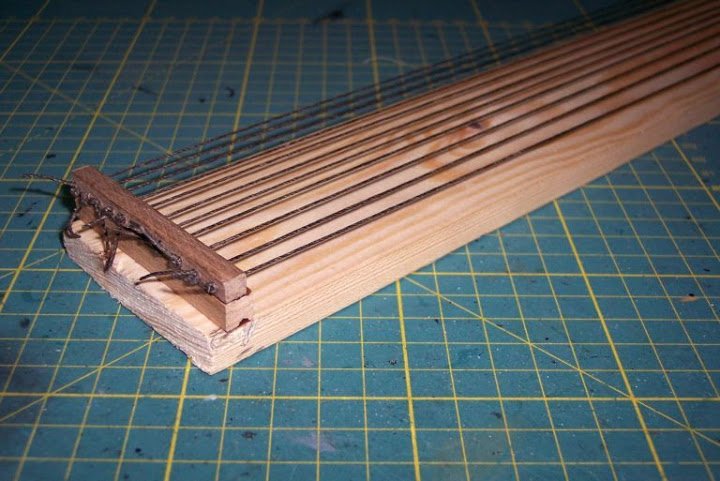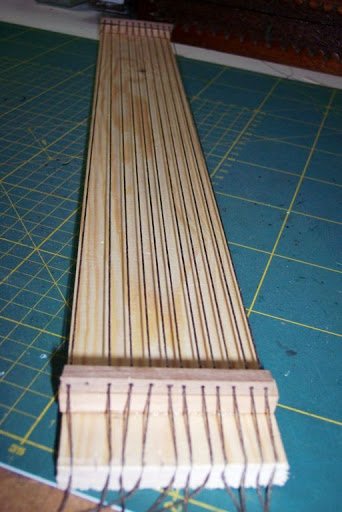-
Posts
4,286 -
Joined
-
Last visited
Content Type
Profiles
Forums
Gallery
Events
Posts posted by Blue Ensign
-
-
She has nice lines David, I look forward to seeing her progress..
Regards,
B.E.
-
Planking is looking good JP, I also like to work from keel up and wale down with hopefully any spiles appearing on the underside of the hull.
Thinking through your system is most of the battle.
Cheers,
B.E.
-
Great progress Robert, love that last shot, shows the sheer lines off a treat

Regards,
B.E.
-
Hi Skippy that’s quite a question.
I do have the Petersson book so I can see what you are referring to.
I didn’t use the book much for rigging Pickle, my main reference sources were The Global schooner by Marquardt , The Colonial schooner by Hahn, and The cutter Alert by Peter Goodwin.
Those tackles referred to by Petersson were not part of the standing rigging as such; with an odd number of shrouds on the Mainmast the shortened leg of one pair had a block turned into the end as shown by Petersson with the tackles set up as per pages 74/75 of his book.
The tackles were used for lifting heavy equipment
With Pickle the tackle pendants were a separate item of rigging going over the masthead first before the shrouds. You can see this on page 76 of Petersson in relation to the Fore Mast.
Instead of a block being turned in the end, I used thimbles into which the tackle block would be hooked when required. The tackles are unrigged on my Pickle, but the pendants with the thimbles can be seen in many of the photos.
The tackles did not always hook into the channels, ring bolts set in the waterways inside the rails were also used.
Rigging Pickle as per Petersson would be a bit crowded on the kit provided channels without some modification, and you would need to watch out for where the gunport splits the Main channels.
Finally thank you for your kind comment about my build.
Cheers,
B.E.
-
Hello Dusty,
What evidence do you have that she was fitted with either fixed stern davits or Quarter Davits, were these a feature of Spanish Ships in general? I've not seen any models of her or paintings depicting her with davits.
Regards,
B.E.
-
Enjoyed reading the trials and tribulations of your build Tony, and you certainly seem to have got value for money out of the learning process.
A model is more than just the sum of its parts and you are producing a very attractive cutter with some nice little additional touches.
Cheers,
B.E.
-
Excellent bit of joinery there Alex, love the final shot, great colour toning.
Regards,
B.E.
-
-
-
Wonderful series of photo's Gil that will help explain the mysteries of Bunt and Leech line rigging. Belaying at the bitts and Foc'sle rail present some of the trickiest to get at locations, and the neatness of your rigging is very evident in the large size photo's.
Very nicely done.
Regards,
B.E.
-
She's shaping up into a very nice model Martin, with some great extra touches. I like your headworks, so often a weakness in kit offerings.
Whether to serve or not ; if it creates an overscale look, a bit bulky , then it is perhaps better not to do it. I have yet to reach that point, I will attempt it, but let my eye be the final arbiter.
Here's the link for Steel.
http://hnsa.org/doc/steel/index.htm
I do have the book, but use the online version all the while, I find it an excellent reference source, and in truth it is the basis for all the more modern writings on the subject.
Regards,
B.E.
-
Hi Bob,
Picked up your log from the photo profile thread, beautiful lines you have achieved with your Bluenose, a very appealing build.
Regards,
B.E.
-
The wheel looks good Jason, and very neat work on the blocks. Rigging the tiller is the first bit of rigging, and you've done an excellent job.
ps, It's never too early to get the next generation interested in the hobby, and your lad looks to be making a good start.

Cheers,
B.E.
-
Hi hamilton, Goodwin includes the crowsfeet as part of the standing rigging in the Blandford book, I would use blackened line.
Regarding the Lion figurehead, many years ago I modified a boxwood chess piece to create a 'lion' figurehead on a scratch1:96 scale model of an early 18th century first rate.
Lions are popular subjects, and if you don't feel confident at sculpting look around for something that might fit the bill.
Cheers,
B.E. -
Hello Paul, i would suggest that the jeer falls having passed through the hooked deck blocks adjacent to the mast were hitched around themselves to secure, or maybe having passed thro' the blocks were secured to cleats attached to the mast.
In the absence of Bitts there doesn't seem any other viable option.
B.E.
-
Hello Ed, I recall seeing your build the first time around and it has lost none of the WOW factor seeing it again. I can only marvel at the quality of your work, a worthy successor to Longridge, and at only half the size.
A wonderful model.
Regards,
B.E.
-
I've just picked up on your build Bill.
That is one hell of a kit bash, in fact the term doesn't really fit at all. Your depth of research, attention to detail, and evident skill is producing a model of exceptional beauty.
A new benchmark for a Mantua kit for sure.
Look forward to seeing more.
Regards,
B.E.
-
Another side project Daniel, with three Victory's on the stocks, how do you do it.

Excellent photo's tho' to assist the weathering of models.
During the Napoleonic era, I suspect most British Ships on blockade duty took on a very weathered look. Refit intervals stretched way over time, and often with very limited local repair facilities.
Contemporary writings record the parlous state of many ships on Blockade and patrol duties, reporting such things as the Quarter Galleries lost or severely broken.
Captain Rose of the Agamemnon whilst on the South American Station in 1809, wrote a report on the 'deplorable' condition of the ship, citing such things as movement in the standard knees and hooks, much decay in the lower deck ports, broken metal work, and beams working loose in the clamps.
One can imagine that a ship returning from many months at sea looked far from Shipshape and Bristol fashion.
I suppose a more modern comparison would be the look of of A Flower Class Corvette in 1942 after a winter in the North Altantic.
M.
-
Fine looking model Rusty, set off by your beautiful ships boats. Confederacy really is an immensely attractive kit.
Well done

B.E.
-
Hi Hamilton, glad your books have arrived, now you have something to get your teeth into.
Regarding the Main Wales, personally I would go with Goodwin. There are plenty of contemporary models of sixth Rates and larger of that era with the distinctive double black Wales picked out, I think it sort of defines the period.
Goodwin does say in his book that the period was one of transition with old and new features being incorporated at the same time, and that the Blandford was unusual in some respects in her construction. This gives you some scope to show differences.
The Crowsfeet at 1:100 scale would be pretty fine, but I think you are right to attempt them, using the finest line you can get hold of.
0.1mm diameter is usually the smallest commerciallly available rigging line, but there may be other options. I would in any case drill the micro holes around the rims of the tops.
Look forward to seeing developments.

Cheers,
B.E.
-
Hello Michael, I was alerted to your build by your post on my own log.
You are doing a very fine job, and like yourself I love it when there are external sources available to correct and improve on the simplifications and errors evident in kits.
The modifications you are making are creating a very special Wasa, and now I know about it I will continue to follow your progress.

Cheers,
B.E.
-
That's a fine pair of catheads Robert, far exceed my own humble efforts on Pegasus.
Well done.

B.E.
-
Well the models are certainly varnished presumably to represent 'bright' sides, and they do correspond pretty well with the contemporary paintings.

M.
-
Hi Jason, when using natural line such as supplied by Jotika, I always pre-stretch and wax the line. This is particularly important with the stays and Shrouds.
Far less tension is required on a stretched line and the risk of pulling masts out of alignment is much reduced
On my models I also like a bit of slack on some of the lines such as the Braces and Bowlines, and stretching allows this to be formed in a natural sort of way.
Lines for the Main and Forestays I tend to hang with weights for some time before use, but for shroud lines I use a home made rack as per below.


This is sufficient to take a set of Shrouds.
To achieve an induced sag or change of direction I recall from German site that diluted wallpaper paste achieved very good results particularly where used to stiffen the multi block crowsfeet prevalent on 17th century ships.
Cheers,
B.E.



HMS Pegasus by flyer - FINISHED - Victory Models
in - Kit build logs for subjects built from 1751 - 1800
Posted
Hi Peter,
I was fairly happy with the position along the hull of the scuppers as per below which I sort of worked out from the Swan II book.
but I'm not really sure whether I should have placed them lower. Here you can see them situated just above the top strake of the wale. There is an incline down from the deck, but when I saw Bill Maxwell's Fly I noted they were lower down exiting thro' the Wale.
http://www.max-jp.biz/fly/Gallery_LR/imgpages/image246.html
The one that I still have to fit is for the Manger scupper at the bows, this would of neccessity be slightly lower than the line of the others on my Pegasus.
http://www.max-jp.biz/fly/Gallery_LR/imgpages/image241.html
It doesn't always follow that the scuppers exit thro' the wale, it does depend on the relationship between the level of the Waterway and wale on a particular ship which may vary.
On my Pegasus I found that the option was to fit them where I have or risk drilling holes just beneath the top of the Wale with the risk of splitting the wale wood. I took the soft option.
According to the ffm book the scuppers were of 1.5mm diameter holes (scale) and for the Pump dales,( the one situated second from aft) 2.0mm; also the Manger scupper at the Bow.
Those tubes you have look good for the normal scuppers but if you can find a couple slightly larger for the Pump dales and Manger outlets that's all to the better.
I hope this provides you with a little more detailed information Peter, in retropsect I think I would have left my external scuppers until much later in the build, were I doing it again.
Regards,
B.E.